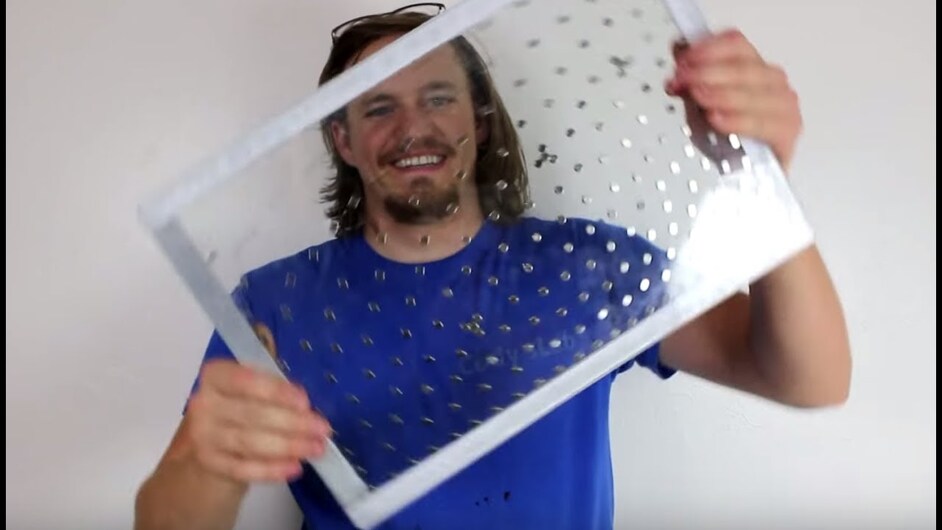I like both so take your pick
That’s not how it works. That’s not how any of this works. ![]()
The volume of the material expands because the space between the atoms/molecules/etc is increasing with the temperature.
As the space increases, the volume of the material increases. As the volume expands, so does the size of the volume of areas that lack material (the holes).
To wit:
Both blocks have the same size particles. The particles are farther apart on the right (same mass, larger volume, lower density), resulting in a larger object, and a larger area of nothing in the middle (the hole).
BUT…
in addition to a larger volume of space, wouldn’t you also have to take into account the relative resistance caused by the material attempting to expand into solid particles as opposed to fluid particles such as air?
In other words, it is easier for the expansion to occur into an empty space - the hole, than it is for it to occur into the solid area of the metal.
Thus shrinking the hole?
(I have no idea…I pretty much slept through Advanced Thermo. Just wanted to get in on the conversation…  )
)
Someone ought to just run an experiment and see what happens. Grab some tight fitting acrylic and run a test. 
I go for easy metaphor. If you have a balloon shaped like a dognut and you keep inflating it, will the hole get bigger or smaller?
It depends. ![]()
Assuming the increased heat is evenly distributed throughout the material, the space between the particles would desire to stay uniform.
If the material is equally constrained in all directions, there would be no change.
If it were constrained equally on opposite sides, the material would stretch into a rectangle shape, and the hole would take on an oval shape. Of course, the density would tend to loose it’s uniformity at that point.
Any thing beyond that (and quite possibly even this) is above my pay grade.
No, otherwise if you heated an object the outer edges would expand more than the middle. A hole near the edge would expand more than one in the middle.
The coefficient of expansion isn’t position dependent. The same thing happens all over, to wit, all the atomic bonds get a bit longer pushing all the atoms and molecules further apart, as in the diagram above.
As long as the object is heated uniformly, it simply scales up a bit. There aren’t any stresses created by the outer material trying to constrain the inner material.
HI Scott
Not sure I followed your comment, but your drawing is just another boundary condition. Which as I said determines the results. Keep in mind there are materials that go just the opposite of your drawing
The expansion is happening because of the particles in the material, not in opposition to them.
The idea that the hole may constrict as the material expands is intuitive. We sometimes see this happening in our everyday world. For instance, the holes in bagels clearly constrict as the bread of the bagel expands. It’s intuitive to think that a “metal bagel”, which I guess would be a washer, would act the same way. It seems that excited particles act differently than air bubbles in dough.
I wonder; do you know the answer? I’d try it if I had any inner tubes around my house. I suspect the hole would get larger for a while, like a washer, but at some point I suspect it would start acting more like a bagel and the hole would get smaller. I wonder how the ratio between the width of one side of the tube and the diameter of the whole tube would influence the way it expands. (Would a monster truck tube be more likely to become a “bagel” than a bicycle tube?)
I figured there might be a video on YouTube showing an inner tube being inflated, but I couldn’t find a good one. Here’s a mildly entertaining one though…
And this recent video by Cody (of Cody’s Lab on YouTube) is sort-of topical…
a+++
Be careful of what resin you use. While curing resin heats up due to the chemical reaction and the acrylic parts could react/ warp with that heat. The acrylic could also react with certain resins and for a white haze around the connecting areas.
Good luck!
I think about cartoon physics and some seemingly common sense, intuitive ways of processing motion. Ask anyone who doesn’t know about Galileo to say which hits the ground first, a ball of lead or a ball of cork. Cartoon physics says the lead ball hits first. Same thing with this understanding of expansion. In cartoons, things always blow up like a balloon. Think of how many cartoons where the tires got over inflated.
An infinite sheet will expand out to a larger infinity. There wont be any constraint that pushes the expanding material back towards the hole.
Infinity + 1 = infinity.
Surely, there must be a Myth Buster episode that applies.
There may be materials that are an exception but for near about forever people have known to heat a race and chill an axle to get a tight fit to go together. Every metal ring (torus) I know of the inner diameter gets larger with expansion.

